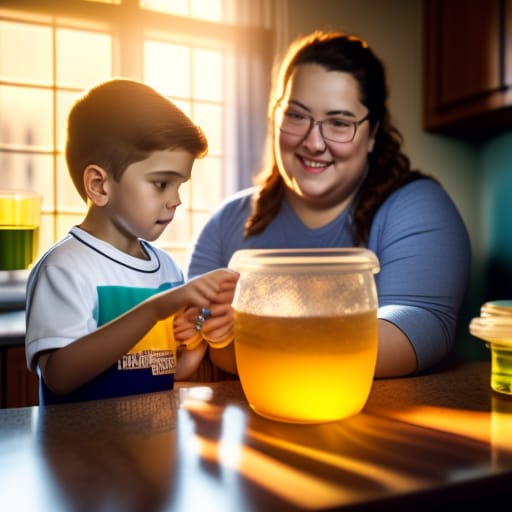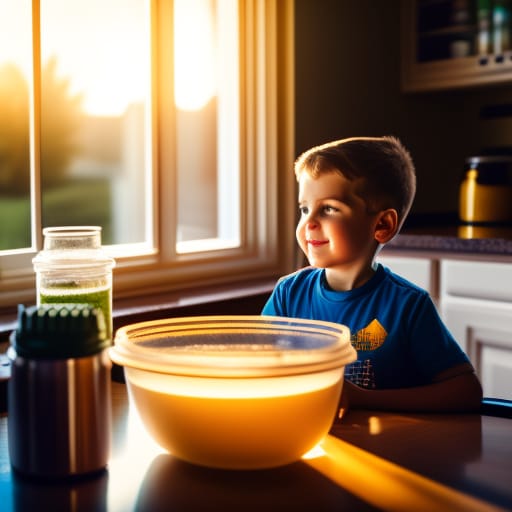Science kits are a great way to spark curiosity and engage in hands-on learning at home. With so many options available, it can be tricky to know where to start. This beginner’s guide will walk you through everything you need to know about getting started with science experiments using kits right at home.

What Are Science Kits for the Home?
Science kits, also known as STEM kits or STEAM kits, are boxes or packages containing materials and instructions for conducting simple science experiments at home. They allow children and adults alike to explore concepts in chemistry, physics, biology, engineering, technology, and math through interactive, engaging activities.
Unlike textbook science, science kits provide a more hands-on learning experience that brings scientific principles to life. They come in all shapes and sizes, from basic starter sets to advanced kits covering specific topics like robotics or forensics. Most provide detailed instructions and explanations so anyone can successfully complete the experiments, regardless of scientific background.
The global science kit market has exploded in recent years as parents and educators realize the value of STEM education and homeschooling. While early kits focused solely on chemistry, today’s kits encompass a wide range of interdisciplinary topics to appeal to diverse interests and age levels. There are even kits designed specifically for adults who want to explore science as a hobby or engage in the same activities as their kids.
Benefits of Using Science Kits at Home
Beyond just being fun, regularly using science kits provides many benefits for children and adults:
- Develops critical thinking and problem-solving skills – Following instructions, making observations, troubleshooting issues, and analyzing results encourages scientific thinking.
- Sparks curiosity and interest in science – Hands-on experiments with tangible results inspire future inventors and scientists.
- Teaches scientific techniques – Using lab equipment, controlling variables, collecting data, and formulating hypotheses are skills gained from kits.
- Boosts STEM abilities – Repetition develops confidence and competence in science, technology, engineering, and math.
- Improves academic performance – Kids who use kits regularly tend to excel at science and related subjects in school.
- Encourages teamwork – Collaborating on experiments builds communication, cooperation, and social skills.
- Builds self-esteem – Successfully completing experiments provides a great sense of pride and achievement.
Using science kits on a regular basis fosters an ongoing passion for science and gives both kids and adults the confidence to pursue related fields.
Types of Science Kits for Home Use
There are now tons of science kit options available online and in stores. Here are some of the major categories and sample activities:
Chemistry Kits
Chemistry kits introduce fundamental concepts like atoms, molecules, chemical reactions, acids, and bases. Typical experiments involve creating slime or oobleck, making pH indicators, growing crystals, producing oxygen bubbles, and identifying mystery compounds.
Safety is paramount when doing chemical reactions, so look for kits with child-safe ingredients. Always read labels and instructions carefully and conduct experiments in a well-ventilated area while wearing goggles.
Physics Kits
Physics kits bring to life concepts like motion, energy, gravity, magnetism, and electricity through hands-on projects. You may build race cars to test speed, create a simple motor or generator, levitate objects, or experiment with circuits.
Look for physics kits that emphasize interactive projects over pre-made gadgets. And make sure to follow electrical safety precautions like adult supervision for younger kids.
Biology Kits
Biology kits foster an appreciation for the living world through activities like growing plants from seeds, nurturing butterflies from eggs, making models of human organs, and examining pond water under a microscope.
Opt for biology kits that avoid harming live animals and use illustrated guides to build knowledge. Kits focused on ecosystems and habitats also teach conservation.
STEM Kits
STEM kits combine science, technology, engineering, and math concepts in hands-on projects like constructing buildings, programming robots, or designing carnival rides. Activities develop skills across multiple disciplines.
Look for STEM kits matched to your child’s interests and abilities. Open-ended building kits with guidebooks allow for endless experimentation and problem-solving.
DIY Science Kits
Prefer to customize science experiments? DIY kits provide materials and loose parts like craft supplies, collecting tools, and generic lab equipment to design your own projects.
Seek DIY kits packed with an assortment of supplies, along with experiment guidebooks tailored to different ages and interests. They allow for unlimited exploration.

Choosing the Right Science Kit
With a dizzying array of science kits out there, it can be tricky to select the best one. Here are key factors to consider when shopping for a kit:
- Age range – Choose kits designed for your child’s age and developmental level based on complexity and safety. Avoid frustrations from kits too advanced or babyish.
- Interests – Select kits that align with your child’s interests – astronomy, robots, geology, animals, health, etc. They’ll be more engaged in topics they’re passionate about.
- Skill level – Kits labeled beginner, intermediate or advanced indicate the required ability level. Evaluate your child’s existing skills before purchasing.
- Learning format – Does your child prefer following step-by-step instructions or more open-ended exploration? Seek kits that match the learning style.
- Educational standards – For homeschooling, look for kits that complement science curriculum standards if that is your priority.
- Budget – Science kits range dramatically in price from $20 to over $100. Set a reasonable budget and remember less expensive kits can be equally educational.
- Safety – Make sure to read age labels and check for potential dangers like chemicals, small parts, sharp objects, or electricity. Supervise younger kids.
Choosing the right kit ensures a fun, safe, and rewarding science experience for any age. Don’t be afraid to try a few different kits to discover where your child’s true interests lie.
Best Science Kits for Kids by Age
Here are some top-rated science kit recommendations for kids of all ages to get you started:
Preschool Science Kits
- Learning Resources Primary Science Lab Set – Kid-safe beakers, test tubes, and tools to introduce early science concepts.
- Scientific Explorer My First Mind Blowing Science Kit – Experiments with bubbles, color changing, and sensory materials.
- Melissa & Doug Science Activity Kits – Themed kits like bubble blowing, magnets, and color mixing.
Elementary School Science Kits
- Thames and Kosmos Chemistry C3000 – Classic chemistry kit with safe household chemicals to create reactions.
- Omano JuniorScope Microscope Kit – Kid-friendly microscope for examining plants, bugs, and everyday objects up close.
- National Geographic Mega Fossil Dig Kit – For budding paleontologists to excavate and assemble skeletons of tyrannosaurs, fish, and more.
Middle School Science Kits
- Scientific Explorer Magic Science for Wizards Only Kit – Entertaining experiments testing air pressure, optical illusions, and floating bubbles.
- KiwiCo Tinker Crate – Monthly science and engineering projects with gears, launchers, vehicles, and structures.
- Backyard Science Experiments Kit – Investigate the natural world outdoors by studying soil, snow, composting, and solar power.
High School Science Kits
- Thames and Kosmos Physics Workshop – Practice concepts like flight, friction, and magnetism through applied projects.
- Dr. Cool Forensics Science Kit – Collect and analyze evidence from simulated crime scenes like a CSI professional.
- Omano Student Microscope Set – Quality compound microscope for high school biology experiments.
This list gives you an idea of the huge variety of science kits tailored for different grade levels. Focus on your child’s areas of interest and skill level to make the experience both fun and educational.
Conducting Safe and Successful Experiments
The key to getting the most out of science kits is properly setting up, performing, and analyzing experiments. Follow this basic process:
Before the Experiment
- Carefully read all instructions and safety notes.
- Make sure you have all the required materials and understand the steps.
- Designate a clean, uncluttered experiment area with good ventilation.
- Tie back long hair, roll up sleeves, and wear goggles and gloves if recommended.
During the Experiment
- Perform steps slowly and deliberately in sequence.
- Use lab tools like pipettes, balances, and mess pads properly.
- Observe all reactions and changes closely.
- Take detailed notes or make sketches of what happens.
- Clean up spills immediately to prevent hazards.
After the Experiment
- Analyze your observations and results. Did they match predictions?
- Form a hypothesis to explain your results based on scientific principles.
- Repeat experiments multiple times controlling variables to test your hypothesis.
- Discuss findings and conclusions with others. What did you learn?
Following the scientific method ensures you actually gain skills rather than just completing projects. Maintaining an experiment journal is also a great idea to track learning.

Science Kit Safety Tips
While science kits are designed to be safe for home use, accidents can happen if not used properly. Keep these safety guidelines in mind:
- Read age labels – Only do experiments designed for your age level. Keep small kids from playing with chemicals.
- Supervise kids – Adult supervision is a must for younger children to prevent misuse.
- Follow instructions – Carefully read and follow all provided safety instructions before starting.
- Use equipment properly – Mishandling lab tools like eye droppers could lead to injury.
- Wear safety gear – Use provided goggles, gloves, and aprons when recommended in instructions.
- Check materials – Make sure chemicals or parts are in usable condition and not expired.
- Work in a clear area – Keep the experiment space free of clutter and away from open flames.
- Dispose properly – Follow disposal directions to avoid contamination.
- Wash up – Always wash hands after experiments and clean tools. Discard clothes exposed to chemicals.
- Have a first aid kit available just in case – Burns, cuts, and irritation can happen.
Stressing safety will allow you to get the most from your science kits worry-free.
Frequently Asked Questions
What are the best science kits for kids overall?
Some top-rated kits across age levels include Omano student microscopes, Green Science kits, subscription kits from KiwiCo, and classic chemistry sets from Thames & Kosmos.
How do science kits help kids learn?
Kids learn science best by actively doing experiments rather than passively reading. Kits provide hands-on projects that reinforce concepts and scientific techniques better than textbooks.
Are science kits safe for young children?
Look for kits labeled non-toxic and appropriate for specific ages. Carefully read safety guidelines. With adult supervision, most kits can be used safely even for preschoolers. Start with entry-level kits before progressing to more advanced chemical experiments.
How much do science kits cost?
Basic kits start around $20, but you can spend over $100 for advanced kits or monthly subscription kits with replenished projects. Set a budget based on your child’s level of interest.
Where can I buy science kits for kids?
Science kits are sold at major retailers like Amazon, Target and Walmart. Specialty stores and education stores like Lakeshore Learning also have excellent selections. Many kits are available online.
Get Started with DIY Science Experiments Today
Science kits provide an invaluable way for kids to engage in STEM learning at home while nurturing their interests and curiosity. With such a vast array of kit options available, you’re sure to find the perfect match for your child’s age and interests.
The key is using science kits regularly over time, not just as one-off projects. Repeated hands-on learning builds critical knowledge and skills. Learning STEM concepts through experiments also works wonders to boost academic performance.
So why wait? Fuel your child’s passion for science today by starting your very own science kit collection. Just be sure to read instructions closely, emphasize safety, and document the discovery process. Who knows – your little one may just find a lifelong hobby…or their future career path!
What types of science experiments are good for gifted students?
Look for more advanced physics, engineering, and robotics kits to challenge gifted kids’ problem-solving abilities. Also, consider open-ended DIY kits and monthly STEM subscription boxes that continually deliver new projects.
How can I use science kits to teach special needs students?
Seek kits that align with your student’s specific abilities and learning style. Opt for kits with visual guides and tactile experiments. Simplify kit instructions as needed and conduct experiments slowly, repeating hands-on practice.
What science kits are best for a school science fair?
Hands-on physics, engineering, or robotics kits lend themselves well to science fair projects. Or create an experiment-based kit of your own focused on measuring and analyzing results over multiple trials.
Should I buy a real chemistry set or a STEM toy kit for my child?
Start with an entry-level STEM toy kit to introduce basic concepts safely. As kids gain skills and show deeper interest around ages 10-12, transition to real chemistry sets for more advanced experiments under supervision.
What safety gear, like goggles and gloves, do we need for science experiments?
Always wear ANSI-approved protective goggles when doing any experiment that could irritate the eyes. Use latex or nitrile gloves when handling chemicals or messier materials. An apron or lab coat offers extra protection.